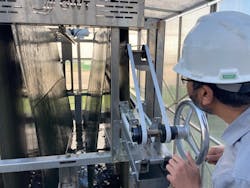MWRD’s pilot algae reactor to test nutrient recovery, carbon offset
Staff at the Metropolitan Water Reclamation District of Greater Chicago (MWRD) are developing an experimental pilot algae reactor, growing algae from wastewater to offset carbon emissions and recover nutrients.
It is the second time the MWRD and Gross-Wen Technologies (GWT) have installed the technology that demonstrates how the MWRD can use algae to naturally uptake phosphorus and nitrogen from wastewater to support its growth through photosynthesis, utilizing the sun as its energy source. Following a successful research trial at its O’Brien Water Reclamation Plant in Skokie, this time around at the Stickney Water Reclamation Plant, MWRD is studying if it can successfully reduce its carbon footprint and meet its long-term goals of becoming carbon neutral.
Thanks to $100,000 in new grant funding from Imagine H2O’s Fourth Annual Urban Water Challenge, GWT constructed the new revolving algal biofilm (RAB) system and greenhouse to analyze how the system can more efficiently recover nitrogen and phosphorus without the use of inorganic chemicals or energy-consuming aeration, which is the traditional method of nutrient removal.
“The pilot algae reactor makes both economic and environmental sense for our taxpayers and our planet,” said MWRD President Kari K. Steele. “Testing experimental technologies to find ways to remove more ammonia using less energy in aeration tanks, while recovering both phosphorus and nitrogen, we are providing numerous benefits that include not only environmental benefits but furthering the science in this important and often overlooked area.”How it works
After solids are removed from the main treatment process, they are digested then dewatered through centrifuges. The extracted water, known as centrate, is conveyed to a nutrient recovery facility at Stickney where phosphorus is collected and converted into a slow-release fertilizer.
The remaining water then flows to the greenhouse where it is cycled through the RAB’s vertical conveyor belts. As wastewater is passed through the RAB, the algae grow on the belts by “eating” the nitrogen and phosphorus from the water. The algal biomass grows even more rapidly by taking carbon dioxide from the atmosphere. While the nutrient recovery facility can recover most of the phosphorus, the algae reactor can recover nitrogen and the remaining phosphorus. Centrate is usually returned to the head of the treatment process and can contain up to 15 percent of the WRP’s ammonia loading.
The algae are mechanically scraped from the belts and can then be utilized as a raw material in the manufacture of a variety of products, such as algae pellets as a slow-release fertilizer, sustainable aviation fuel and bioplastics. Each of these products will reduce a reliance on petroleum.
Furthermore, the algae can also be composted with biosolids and land-applied as a soil amendment, digested to produce biogas, or processed as aquaculture feed — all of which return the phosphorus to the nutrient cycle. With the right amount of sunlight, nutrients, water and carbon dioxide, the MWRD can harvest more algae.
The RAB technology was developed by GWT’s founders while performing research at Iowa State University. The system was initially developed to produce biofuels but was later adapted for treatment of municipal wastewater. The current pilot system can recover approximately 1.5 pounds per day of dry algae biomass which results in the capture of about 3 pounds of carbon dioxide per day.
Why it matters
Ammonia (a form of nitrogen) presents a challenge for water reclamation plants. It can originate from human waste or cleaning chemicals, and it is the MWRD’s job to collect it in wastewater and convert it into nitrate through nitrification followed by denitrification, where the nitrate is reduced to nitrogen gas that is released into the atmosphere. The algae system in comparison assimilates (eats) ammonia and bypasses the nitrification/denitrification process.
By removing ammonia via assimilation, the algae system can further reduce carbon emissions by limiting the nitrous oxide emissions which are generated during the conventional ammonia removal process. Nitrous oxide from treatment processes and treated water resulted in approximately one-third of the MWRD’s 2021 carbon emissions.
If the pilot proves to be successful and can be scaled to the MWRD size, the MWRD can use the RAB system to reduce ammonia more efficiently by using less energy at blowers to pump oxygen. Not only will the MWRD not require as much electricity for its blowers, but it can also potentially reduce chemical costs.
“Our RAB, algae-based treatment process will allow the MWRD to continue its efforts in protecting water quality while also making a positive environmental impact by reducing carbon emissions,” said GWT’s President Dr. Martin Gross.
If the pilot study proves effective and scalable, the MWRD will consider expanding the RAB to treat more water on a larger scale following technical and economic analysis. By treating 2 million gallons of water per day, the MWRD believes it can reduce its carbon emissions by up to 5,000 metric tons of carbon dioxide equivalents per year.
“We thank Imagine H2O, our staff and our partners at Gross-Wen Technologies for selecting our Stickney Water Reclamation Plant to implement this groundbreaking research,” said MWRD Vice President Kimberly Du Buclet. “If successful, the pilot algae reactor can lead to innovation that will reduce energy use, lower carbon footprints and improve resource recovery of valuable nutrients that we can reuse to build a more sustainable environment.”

